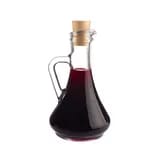Ingredients
Make sure you have...
Utensils
Stovetop, Pot (small), Frying pan, Grater
recipe

Step 1
In a pot of salted boiling water, cook the rice according to package instructions. Once cooked through, drain the rice.

Step 2
Meanwhile, slice the pork tenderloin into thick slices, approx. 2 cm.

Step 3
In a pan, melt a dab of butter over high heat. Add the pork & sauté for 5 min, flipping halfway through cooking.




Step 4
Lower the heat to medium. Add the soy sauce, vinegar, sugar & grated ginger. Stir, cover & leave to simmer 6-7 min, over low heat.
Step 5
Serve the caramelized pork on a bed of fluffly rice. Re-season to your taste & enjoy ! *Check out our tips for this step

For a truly flavoursome dish, we suggest serving the pork & rice with some grated carrots & a side of spicy cucumber salad.
- Domitille, Food Editor
Personal notes
Add your own flavor!
Nutrition facts
Average estimated amount for one serving
| Energy | 428 cal. |
| Fat | 6 g |
| Carbohydrates | 61 g |
| Protein | 33 g |
| Fiber | 0.9 g |
Values are based on an average estimate for one serving. All nutrition information presented on Jow is intended for informational purposes only. If you have any concerns or questions about your health, please consult with a health-care professional.
On average, one serving of the recipe "Vietnamese-style Caramelized Pork" contains 428 Energy, 6 g of Fat, 61 g of Carbohydrates, 33 g of Protein, 0.9 g of Fiber.
Price per portion
| € | Nos recettes à -2 € par portion |
| €€ | Nos recettes entre 2 € et 4 € par portion |
| €€€ | Nos recettes à +4 € par portion |
Please note, the price above is dependent on your grocer and the available products in the grocery store you chose.
Scores


C Nutri-score
The Nutri-score is an indicator intended for understanding nutritional information. Recipes or products are classified from A to E according to their food composition to promote (fiber, proteins, fruits, vegetables, legumes, etc.) and foods to limit (energy, saturated fatty acids, sugars, salt, etc.).
C Green-score
The Green-score is an indicator representing the environmental impact of food products. The recipes or products are classified from A+ to F. It takes into account several factors on the pollution of air, water, oceans, soil, as well as the impacts on the biosphere. These impacts are studied throughout the product life cycle.
Retrieving reviews...



